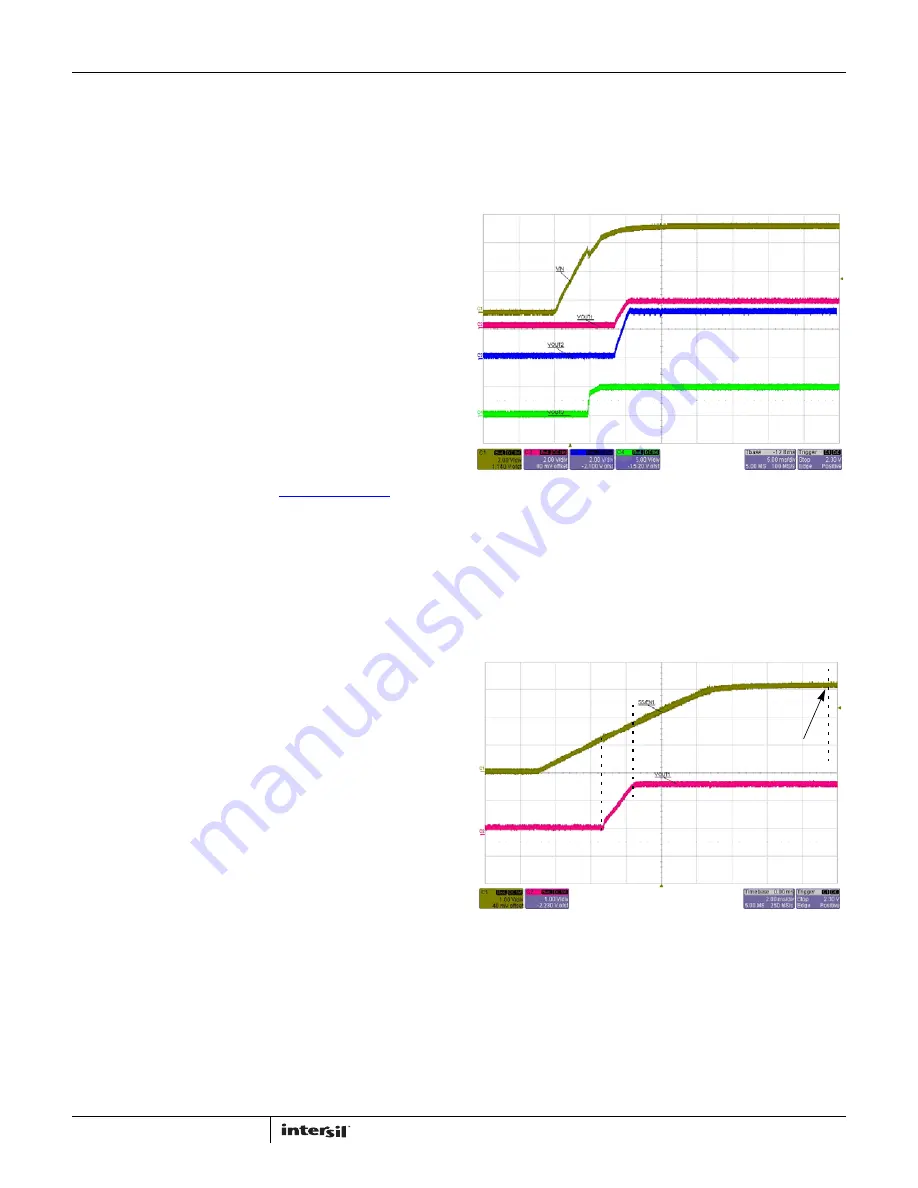
Application Note 1181
2
AN1181.1
November 28, 2011
actual loads can be used. It is STRONGLY recommended that the
power be turned off when attaching loads, due to the tight
spacing of the posts. The switcher outputs should be able to
provide at least 3A; monitor the FET temperature if you try to go
higher, to be sure the conditions will allow it. Make sure the input
power supply can source the amount of input current necessary
to drive the maximum loads to be tested.
The linear VOUT3 is especially sensitive to power dissipation
concerns; it will change as the user varies either the input
voltage, the output voltage, and/or the load current. The
equation used is PV
OUT3
= (V
IN3
-V
OUT3
)*I
OUT3
. The PNP bipolar
will also be rated for how well the power is dissipated from the
package and spread out on the board; this is another variable
that the user must keep in mind for their design and layout.
JP1 is used to disable VOUT1, by shorting SS/EN1 to GND. JP2
does the same function for VOUT2.
The switching frequency is controlled by a resistor (R4) on the RT
pin, to GND. Refer to the datasheet for the curve of resistor
values versus frequency.
Each output voltage is determined by a resistor divider from the
output to its FB pin to GND. See the
ISL6442 datasheet
for the
formulas to calculate the values. Note that there are some
limitations; the switchers can approach 100% duty, but will be
limited by dead time, r
DSON
of the FETs at maximum load,
switching frequency, etc. The maximum values are limited by the
VIN available (if you want go higher, check the ratings of the FETs,
and other output components to be sure they can handle it). The
minimum output voltage will be just above the 0.6V internal
reference. The maximum output voltage for the linear is limited
by the VIN3 and the LCDR pin (which is biased from 5V). Thus, the
maximum output voltage is close to the 5V set on the board; it is
not recommended to go higher. The minimum voltage will also
be just above the 0.6V internal reference.
Performance Waveforms
These figures depict the ISL6442EVAL1Z performance during
typical operational situations, as well as during fault conditions.
Loading of the output can be most easily done via an electronic
load; however, other methods can work as well.
Figure 3 shows a typical power-up sequence, with all inputs
connected to a single VIN = VIN3 = 6V. When VCC exceeds its
POR rising trip point (~4.4V), the IC is enabled, and the linear
VOUT3 comes up almost immediately. Meanwhile, the two SS/EN
pins start charging (not shown), but the outputs do not start
ramping until the SS/EN pins ~1V; then both switcher outputs
start their soft-start ramps at the same time. In this case, both
outputs track each other initially; this is accomplished by
selecting the ratio of SS/EN capacitors to match their output
voltages. The ramp times shown are on the order of a few
milliseconds, as determined by the SS/EN capacitors on the
board.
Figure 4 shows the detail soft start waveform of PWM1 (PMW2
would be similar). The full SS/EN1 ramp is shown; the output
doesn’t start to ramp until the SS/EN passes the ~1V threshold
for Enable. The output ramps from zero to full scale, while
SS/EN1 ramps from 1.0V to 1.6V. Finally, the EN/SS1 keeps
ramping up to ~3.2V, at which point the ramp is considered done
(the PGOOD timer would start from this point, if both outputs
ramps were done).
FIGURE 3. TYPICAL POWER-UP WAVEFORMS WITH VIN
CH4 VOUT3
(5V/DIV)
CH3 VOUT2
(2V/DIV)
CH2 VOUT1
(2V/DIV)
CH1 VIN
(2V/DIV)
5ms/DIV; VIN3 = VIN
CH1 OUT1
(1V/DIV)
CH1 EN/SS1
(1V/DIV)
2ms/DIV
FIGURE 4. PWM1 SOFT-START
~3.2V



























